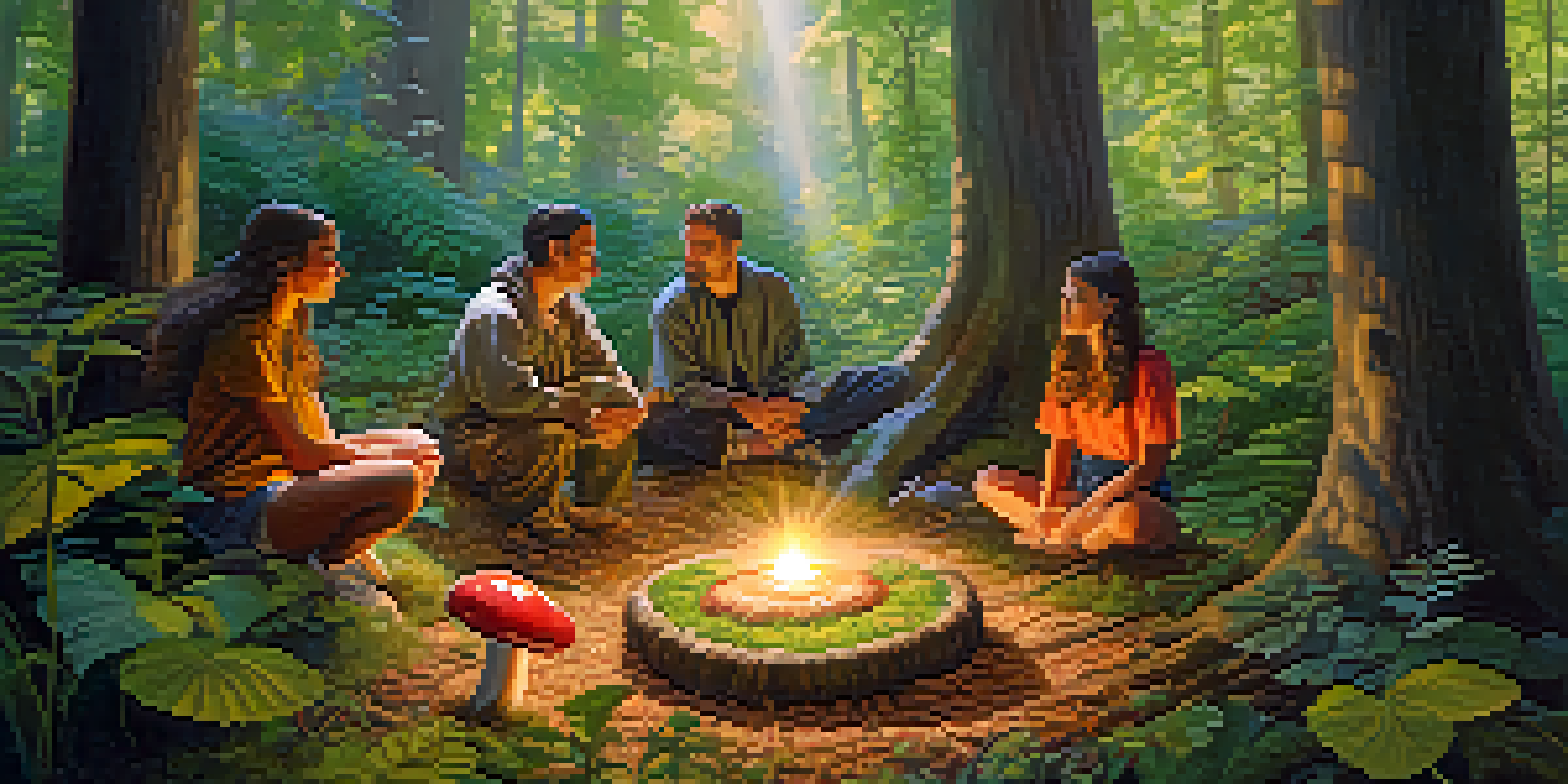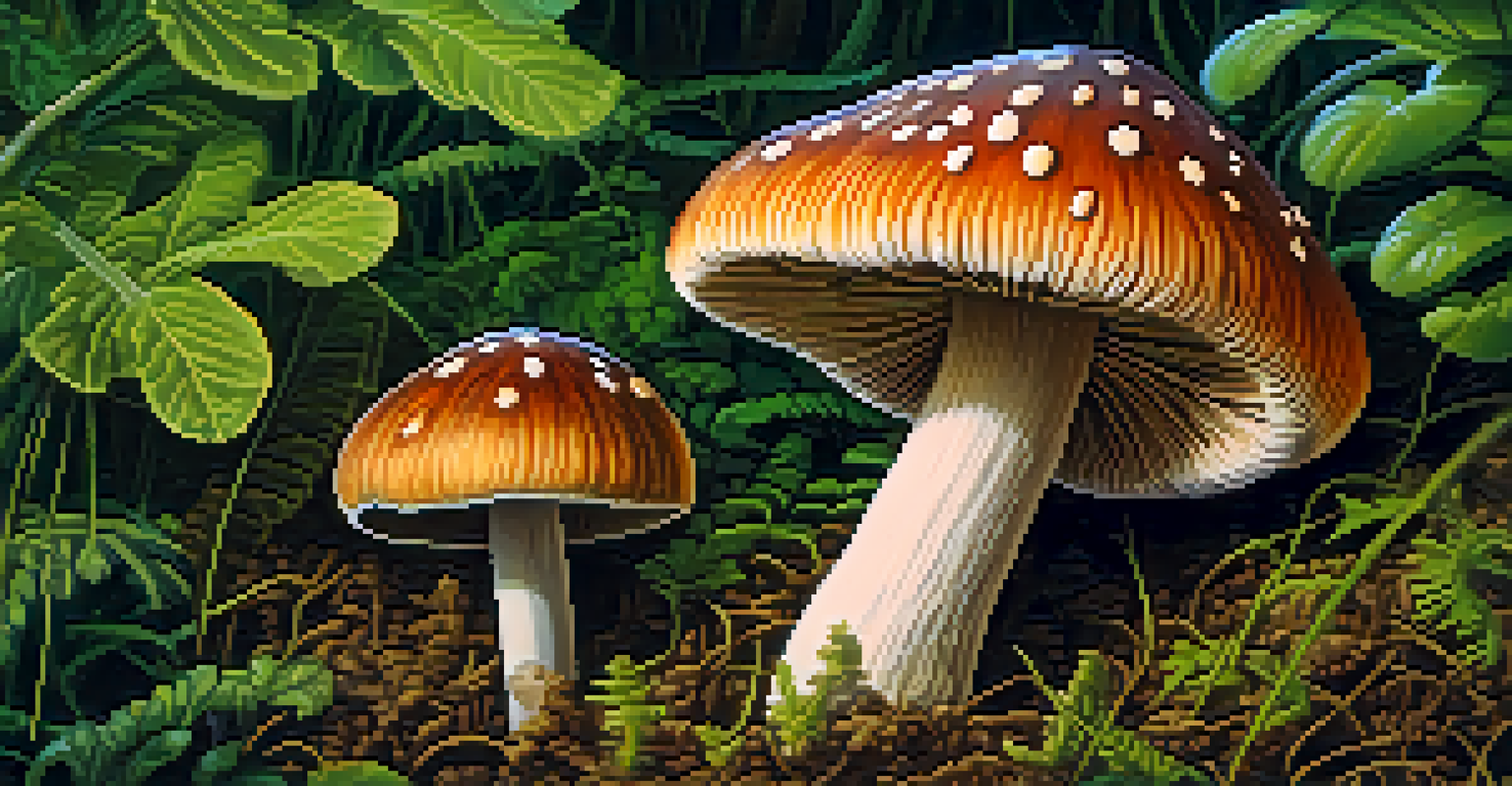Shamanic Practices: The Use of Mushrooms in Healing Rituals

Understanding Shamanism and Its Healing Practices
Shamanism is an ancient spiritual practice that connects the physical world with the spirit realm. Shamans, often viewed as healers and guides, utilize various techniques to facilitate healing and personal growth. These methods can include drumming, chanting, and the use of natural substances, including mushrooms.
Psychedelics can be a doorway to understanding the deeper aspects of our consciousness.
At its core, shamanism emphasizes the importance of nature and the interconnectedness of all living beings. This holistic approach allows shamans to access deeper levels of consciousness, helping individuals confront their issues and gain insights into their lives. By understanding this framework, we can better appreciate the role of mushrooms in these rituals.
Mushrooms, particularly those containing psychoactive compounds, are often used by shamans to induce altered states of consciousness. This can lead to profound personal revelations and healing experiences, making them a vital part of the shamanic tradition.
The Role of Psychedelic Mushrooms in Shamanic Healing
Psychedelic mushrooms, such as psilocybin, have been used for centuries in various cultures for their mind-altering properties. These mushrooms can help individuals explore their emotions, confront fears, and find clarity in difficult situations. In shamanic healing, they serve as a bridge between the physical and spiritual worlds.

When consumed in a safe and supportive environment, these mushrooms can facilitate deep introspection and connection with one's inner self. This journey often leads to transformative experiences, allowing individuals to release trauma and gain new perspectives on their lives. The shaman acts as a guide during this process, ensuring a safe passage through the experience.
Shamanism Connects Spirit and Nature
Shamanism is a holistic practice that emphasizes the interconnectedness of all living beings and uses various techniques for healing and personal growth.
Moreover, the communal aspect of these rituals fosters a sense of connection and support among participants. Sharing the journey with others can amplify the healing effects, as vulnerabilities are acknowledged and embraced within the group.
Cultural Perspectives on Mushroom Use in Healing
Different cultures around the world have embraced mushrooms in their healing practices, each with its own unique traditions and beliefs. For instance, indigenous peoples in the Americas have long used psilocybin mushrooms in sacred ceremonies to connect with the divine. Their rituals often involve storytelling, music, and dance, creating a vibrant atmosphere for healing.
The greatest medicine of all is to teach people how not to need it.
In contrast, certain Asian cultures have also recognized the medicinal properties of mushrooms, though often focusing on non-psychedelic varieties. These mushrooms are used in traditional medicine to promote physical health and well-being, showcasing the versatility of fungi in healing practices.
Understanding these cultural perspectives can deepen our appreciation for the role of mushrooms in shamanic healing. It highlights that while the methods may differ, the underlying goal remains the same: to promote healing, connection, and spiritual growth.
The Science Behind Psychoactive Mushrooms
Recent scientific research has begun to validate the therapeutic potential of psychoactive mushrooms, particularly psilocybin. Studies have shown that psilocybin can significantly reduce symptoms of depression, anxiety, and PTSD, making it a promising avenue for mental health treatment. This growing body of evidence is bringing ancient practices into the modern therapeutic landscape.
The active compound, psilocybin, is converted into psilocin in the body, which interacts with serotonin receptors in the brain. This interaction can lead to altered perceptions, emotional release, and a sense of interconnectedness, all of which can be beneficial in a healing context. As we delve deeper into the science, we uncover the mechanisms that make these ancient practices effective.
Psychedelic Mushrooms Facilitate Healing
Psychedelic mushrooms, like psilocybin, are used in shamanic rituals to induce altered states of consciousness, promoting deep introspection and transformative healing experiences.
However, it is essential to approach this research with caution and respect for traditional practices. As interest in psychedelic therapy grows, maintaining the integrity of shamanic rituals and honoring their cultural significance should remain a priority.
Preparing for a Shamanic Mushroom Ceremony
Participating in a shamanic mushroom ceremony requires careful preparation to ensure a safe and meaningful experience. This often involves setting intentions, which serve as guiding principles for the journey ahead. By reflecting on what you hope to achieve, you can foster a more focused and productive experience.
Additionally, it's crucial to find a qualified shaman or facilitator who can guide you through the process. Their expertise not only ensures safety but also enhances the overall experience by providing support and insight during the journey. Trusting your guide can help you navigate the complexities of your inner world.
Finally, creating a comfortable and supportive environment is vital. This includes choosing a serene location, preparing the space with meaningful objects, and surrounding yourself with supportive participants. A well-prepared environment sets the stage for deeper exploration and connection.
Potential Risks and Considerations
While the benefits of shamanic mushroom rituals can be profound, it's important to acknowledge the potential risks involved. Not everyone is suited for a psychedelic experience, especially those with a history of mental health issues or a predisposition to certain conditions. Open and honest communication with your facilitator about your personal history is essential in determining if this path is right for you.
Moreover, the quality and sourcing of mushrooms can greatly impact the experience. Ensuring that the mushrooms are from a reliable source can minimize the risk of consuming harmful substances. Participants should be aware of the legal implications as well, as the legality of psilocybin varies across different regions.
Cultural Perspectives on Healing Practices
Different cultures utilize mushrooms in unique ways for healing, showcasing their versatility and the shared goal of promoting spiritual growth and connection.
Lastly, integrating the experience afterward is crucial for lasting change. Taking the time to reflect on insights gained during the ceremony can help solidify the healing process and encourage personal growth in everyday life.
Embracing the Journey of Healing with Mushrooms
Engaging in shamanic practices using mushrooms can be a profound journey toward healing and self-discovery. It invites individuals to confront their innermost fears and desires while fostering a deeper connection with themselves and the world around them. This journey, however, is not solely about the mushrooms; it’s about the intentions, community, and guidance that accompany the experience.
As we continue to explore the intersection between ancient wisdom and modern science, the potential for healing expands. The integration of shamanic practices into contemporary therapeutic frameworks offers new hope for those seeking alternative paths to mental wellness. Embracing these practices allows us to honor the rich traditions that have paved the way for our understanding of healing.

Ultimately, whether through direct participation or simply learning about the practices, there is much to gain from understanding the role of mushrooms in healing rituals. Each journey is unique, and by approaching it with an open heart and mind, we can uncover new layers of healing and transformation.